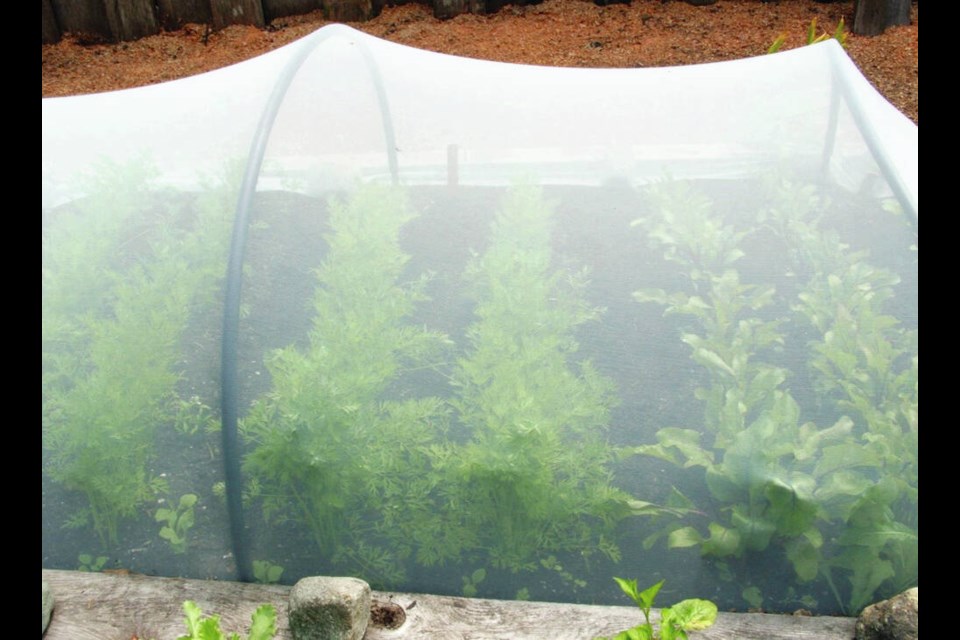Dear Helen: I have been gardening for many years, but over the past five growing seasons my leafy vegetables, such as chard, spinach and beet leaves, have been damaged by leaf miners. I try to remove the ruined leaves when I see them, but more always appear. Is there a way to successfully control this insect pest?
H.S.
Picking off individual leaves and destroying them works as a control only where leaf miner populations are light. In areas where the insects are in significant numbers, covering the plantings with insect netting or floating row covers is the only sure way to maintain clean leaves on the plants.
Growing vegetables that need covering against insect pests in the same bed simplifies the covering. I grow beets and carrots (otherwise marred by rust fly larvae) together in a 120-cm wide bed for easy covering. Lightweight floating row covers designed for use as insect barriers need no supporting structures. They lift up atop the plants as they grow, “floating” over the planting. Insect netting is more substantial and needs supporting hoops or some other structure to hold it above the plants.
Over a growing season there are several generations of beet and spinach leaf miners. The adults, tiny grey flies, lay eggs on the undersides of leaves. The eggs hatch into larvae that tunnel in between upper and lower leaf surfaces and feed there, creating discoloured blotches and tunnelling.
Plantings can develop in unmarred condition for years before insect pests discover and infest them. I grew bulb onions with success without any protective measures for 25 years before a season came when onion flies discovered the planting and their larvae ruined every bulb.
Dear Helen: As I’ve been watering my indoor plants this winter, I’ve noticed that the water draining into the pots’ saucers seems to be creating a fruit fly problem. There are not many, but I’m puzzled at their presence because there are no fruits or vegetables nearby. How can I eliminate the flies?
N.S.
Small flies hovering around house plants are not fruit flies. They are fungus gnats. The gnats lay eggs in potting soils. The resulting larvae, tiny white worms, feed on organic matter in the soil and on plant roots.
Fungus gnats are commonly brought into homes from eggs or larvae in the soil of newly purchased house plants or plants brought back indoors after a summer outside. Sometimes, they are in potting soils used for house plants.
For a few years I had significant infestations of fungus gnats in the flats of transplants I grow under plant lights. The infestations disappeared when I changed the purchased soil component of my seeding and transplanting mix.
A primary prevention measure is to check bag labels carefully to make sure the planting mix you purchase for house plants (and indoor seeding and transplanting) is indicated for indoor use.
Fungus gnat life and breeding proliferates in wet soils. Letting a top layer of soil dry before watering again, moderately, is helpful. To trap adults I have used yellow sticky traps, available at garden centres and from most seed and garden catalogues. The ones I used are Safer’s Sticky Stiks Houseplant Traps
Little flies in kitchens, around fruit and kitchen compost containers, are fruit flies. They arrive indoors on purchased or harvested produce. The flies are most troublesome in late summer and early autumn, when they are attracted to ripe and rotting food.
Home-made traps of apple cider vinegar with a drop of vegetable oil in shallow glass jars work well to keep their numbers down.
Yellow sticky traps attract and trap fruit flies as well as fungus gnats. In the fall, I often place one or two beside the kitchen sink.
The sticky traps should be used only indoors. Outdoors, they will attract and destroy beneficial insects as well as flying pests.
GARDEN EVENT
Seedy in Qualicum. “Seeding the Future” is the theme of the 19th annual Qualicum Beach Seedy Saturday, from 10 a.m. to 3.30 p.m. in the QB Civic Centre, 747 Jones St. The large hall will be filled with seed and plant vendors, with more vendors and exhibits outdoors. There will be a seed swap, advice from Master Gardeners, and the Seedy Cafe. A municipal truck will be on hand to receive unwanted pesticides and herbicides. Admission is by donation. qbseedysaturday.ca



